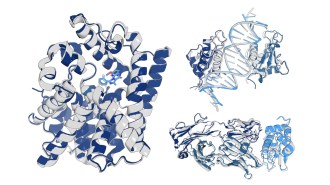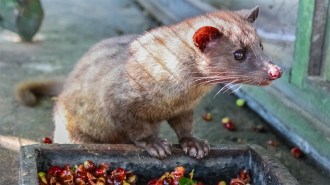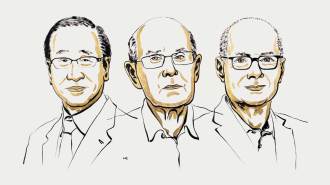- More than 2 years ago
In 1882, British physicist Lord Rayleigh proposed that under certain conditions, droplets of liquid could spout microscopic jets of fluid. Now, for the first time, a series of images has clearly captured the droplets in the act.

Rayleigh theorized that a droplet of liquid becomes unstable and emits these jets when electrostatic forces between charges on its surface become too great for the droplet’s surface tension to oppose. As the jetting fluid rids the droplet of charge, the droplet becomes stable again.
Such charged particles are found in thunderstorm clouds, but they’re also at the heart of a mass spectrometry technique widely used to analyze large biological molecules, says Thomas Leisner at Technische Universität Ilmenau in Germany. Last year, the Nobel Prize in Chemistry recognized that technique, called electrospray ionization (SN: 10/19/02, p. 245: Nobel Chemistry: Laureates’ techniques enable researchers to probe large biomolecules).
In the Jan. 9 Nature, Leisner and his coworkers in Germany report using electric fields to suspend charged droplets of ethylene glycol in a chamber. As the droplets shrank through evaporation, their surface tension decreased, allowing electrostatic forces to become dominant. The researchers then captured high-speed microscopy images of the droplets at varying intervals after they became unstable.
The images reveal that a destabilized droplet elongates, emits fine jets of liquid in opposite directions after 155 microseconds, and then returns to a stable spherical shape. As the jets disintegrate, they form about 100 daughter droplets that collectively carry away one-third of the original droplet’s charge but just
0.3 percent of its mass, the researchers report.
Through experiments such as this, the process by which droplets spout out material becomes better understood, says James N. Smith of the National Center for Atmospheric Research in Boulder, Colo., who studies charged particles in atmospheric chemistry.
Such information could aid in fine-tuning mass spectrometry techniques, he suggests.
However, Smith notes, other research groups have determined different values for the amount of charge and mass that leave unstable droplets, so the new report isn’t the final word quantitatively.
“I find the high-speed photos very informative of the mechanism of breakup,” adds E. James Davis of the University of Washington in Seattle, another researcher in the field. “The great Lord Rayleigh would be pleased.”
****************
If you have a comment on this article that you would like considered for publication in Science News, please send it to editors@sciencenews.org.






